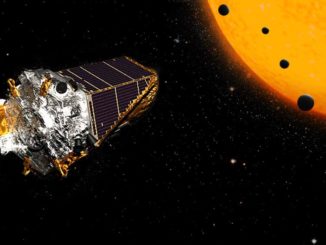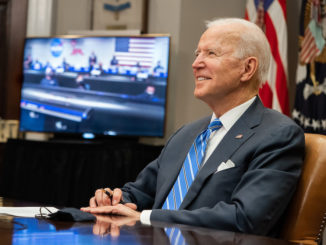CAPE CANAVERAL — Bulking up NASA’s constellation of tracking stations in the sky that provides critical links between orbiting spacecraft and ground control, a United Launch Alliance Atlas 5 rocket successfully deployed a new communications hub in space today.
NASA’s Tracking and Data Relay Satellite series, a program that revolutionized mission operations for U.S. human spaceflight and robotic craft, is now in its fourth decade and this morning orbited its 12th satellite.
“TDRS is a critical national asset have because of its importance to the space station and all of our science missions, primarily the Hubble Space Telescope and Earth science missions that use TDRS,” said Tim Dunn, NASA’s TDRS-M launch director.
With its main engine running at full throttle, the Atlas 5 booster lifted off at 8:29 a.m. EDT (1229 GMT) from Complex 41 at Cape Canaveral.
The 191-foot-tall rocket, generating 860,000 pounds of thrust, aimed eastward and accelerated out of the atmosphere with NASA’s TDRS-M spacecraft.
Within just five minutes, the rocket had shed 92 percent of its liftoff weight and transitioned to the high-energy Centaur upper stage.
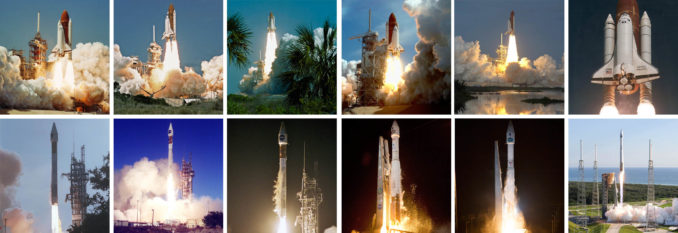
An elliptical parking orbit was achieved within 18 minutes of takeoff, beginning a 90-minute quiescent coast higher through space to reach the optimum conditions for the second burn by Centaur.
That minute-long boost over the Indian Ocean propelled the 7,610-pound payload into a customized high-perigee geosynchronous transfer orbit.
The spacecraft was deployed by the launcher at T+plus 1 hour, 53 minutes to cheers and handshakes all around.
“Obviously, there is a lot of relief on the team right now, a lot of celebration, a lot of excitement. I love spacecraft separation. It is the best part of a launch campaign,” said Dunn.
“So many hours are spent getting to this exact point when you know you have a healthy satellite that just separated from the launch vehicle about to go do its mission that it was intended for.”
Trajectory analysis in. Injection accuracy was within 1% of prediction #TDRSM
— Tory Bruno (@torybruno) August 18, 2017
Trajectory specialists had worked pre-flight to optimize the TDRS-M orbital injection, using up all of the available Atlas 5 performance to extend the satellite’s useful life by two additional years.
The rocket put the satellite into an orbit that allows the craft to save some of its onboard fuel supply from the upcoming orbit-raising maneuvers and apply that to orbital life.
This marked the 143rd consecutive successful Atlas program launch spanning more than two decades, the 72nd for an Atlas 5 and the 120th for United Launch Alliance.
What’s more, it was the 15th NASA use of the Atlas 5 and 28th mission conducted by ULA for NASA, all done successfully.
The Centaur, with its job completed, was expected to fire its engine later to reach a safe disposal orbit with a perigee above the usable low-earth orbit regime and apogee beneath the geosynchronous belt to guard against orbital debris.
Contact was established with TDRS-M, allowing controllers to determine that the satellite was healthy following arrival in space. The craft was the 76th and final to be built on Boeing’s 601 satellite design, and it’s successful launch was the 68th for the program dating back 25 years.
The first order of business for TDRS-M will be severing the straps that held the craft’s two 15-foot-diameter graphite composite mesh antennas partially curled like taco shells to fit within the rocket’s nose cone for launch.
“We need them unfurled and full shape to provide the RF performance for the communications services that our mission is founded upon. So one of the first things that happen after we release from the Centaur is we cut the furling straps and unfurl our reflectors It will take a period of a month or so to what we call ‘relax’ and return to their original shape to give us the full performance,” said Dave Littmann, NASA’s TDRS project manager.
Animation of TDRS-M orbit raising and deploying antennas and solar arrays in orbit. Credit: NASA/Scientific Visualization Studio
While giving the antennas time to relax, orbit-raising maneuvers using the satellite’s onboard main engine will be conducted over the next two weeks to achieve a circular geosynchronous orbit over the equator.
“We need about five burns that will take us from the drop-off spot to the geosynchronous location where we will be operating the spacecraft for its lifetime,” Littmann said.
“From there, we go through the deployments. We unfold the solar arrays and deploy our antennas — those unfurled big reflectors and the Space-to-Ground Link antenna, it’s smaller but still critical to the mission. The SGL is the lifeline to the ground. That process takes 3-5 days.”
If all goes well, control of the satellite will be handed from Boeing’s facilities in California to NASA’s White Sands Complex in New Mexico about three weeks after launch to begin on-orbit checkout.
“The government hasn’t accepted the spacecraft yet. All of the on-orbit testing (is done) from the White Sands Complex with a Boeing team to check the spacecraft out — the bus and the payload — to make sure all of our RF communications services are ready. About four months after launch, in January or so, we will look to schedule an On-Orbit Acceptance Review to review all of the data accumulated from the test program and determine, hopefully, that the government is in position to accept the spacecraft from Boeing. For the whole period to that point the spacecraft is Boeing’s responsibility,” Littmann said.
All of that testing will occur with the satellite parked over 150 degrees West longitude. Once NASA takes acceptance of the craft, the agency’s Space Network assumes ownership, performs its own one-month checkout and then repositions the asset, likely over the Atlantic Ocean Region, Littmann said.
The $408 million TDRS-M was built and launched with the sole purpose to extend the useful life of NASA’s constant communications infrastructure, supporting the astronauts around-the-clock aboard the International Space Station, supplying contact with the Hubble Space Telescope and transmitting the data from almost 40 science spacecraft studying Earth’s environment and space.
“The (TDRS-M) spacecraft continues our ability to provide a data path for communications and tracking services from all of the different users out there in orbit today from human spaceflight component of NASA to robotic missions,” Littmann said.
Credit: NASA/Scientific Visualization Studio
Looking down from the vantage point of geosynchronous orbit, the TDRS network receives signals from vehicles like the space station flying at a mere 250 miles above Earth and routes the telemetry, voice, video and science information to a dedicated ground terminal for delivery to Houston.
No matter where the space station is located at any given moment, TDRS has the outpost in sight for the two-way communications.
“It works really well…We are almost spoiled now with how much communication we have. It really makes the science output and the ability to operate space station as miraculous as it is,” said astronaut Stephen Bowen.
The TDRS system was born in 1973 to keep astronauts and satellites in constant contact with mission controllers, closing the substantial gaps every orbit as spacecraft passed into and out of range of ground stations scattered around the globe.
When TDRS first became operational in late 1983, the initial space shuttle mission to use the system relayed more information to the ground during its 10 days in orbit than in all 39 previous American manned spaceflights.
Relying on dispersed ground stations was a costly requirement and subjected the sites’ operators to dangerous conditions in far-off countries, yet the system provided only 15 percent communications capability per orbit.
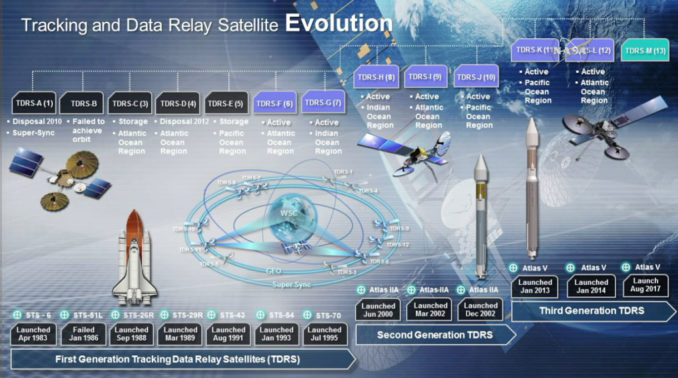
NASA currently has 7 operational TDRS satellites — two launched by the space shuttle in 1993 and 1995 and five Atlas-launched birds from 2000 to 2014, plus two aged shuttle-era craft from 1988 and 1991 now held in reserve with diminished capabilities.
“We need at least 6 active spacecraft and one active spare, so we need at least 7 spacecraft to be ready to meet all of our mission requirements. The first generation has some residual capability, (but) TDRS-M is so critical,” said Badri Younes, deputy associate administrator for Space Communications and Navigation at NASA Headquarters.
A successful TDRS-M extends the projected life of the constellation to the mid-2020s.
While TDRS got its start by supporting space shuttle missions, today’s network is even busier with the space station that’s been continuously staffed for nearly 17 years.
“The thing we saw during the shuttle era was that when a shuttle would go up on a mission, the load on the TDRS system was extremely high. But once it landed that spike in the load would dissipate. We would see the spikes mission by mission,” Littmann said.
“What we see today is a little different because those spikes are no longer there, but with the space station being in continuous coverage where we have astronauts 24/7 in orbit. TDRS serves the human spaceflight community in that manner, the comm to the space station is more continuous.
“The spikes have changed to a continuous level to support the International Space Station activities, as well as TDRS developed additional capabilities over the years that it now tracks and provides telemetry for various launch vehicles. That’s been added to the mix. The overall usage has remained.”
The Atlas 5 rocket that launched TDRS-M, for example, used the constellation’s K and L satellites to relay data back to the Cape this morning. Delta 2 and Delta 4 rockets and Orbital ATK’s Minotaur 4 rely on TDRS too.
TDRS-M completes the third generation of spacecraft constructed for the Tracking and Data Relay Satellite System as we know it today. What comes next is being debated, including possibilities of a “technology refresh” by adding laser communications to the follow-on program.
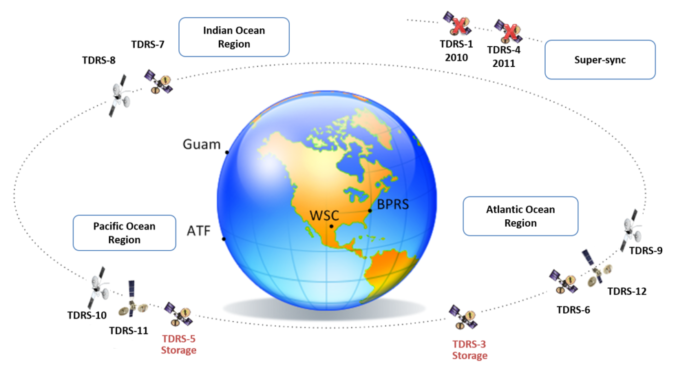
However, there is no rush to field the next era of relay satellites. The current TDRS fleet is expected to operate well into the next decade.
Only two of the six shuttle-launched TDRS satellites have been retired, the rest are functional more than 25 years since their deployment and outliving their design lives by exceptional margins.
“Just because the 15 years comes to end doesn’t mean we stop operating the spacecraft. Like your electronics or laptop at home, you use it until it doesn’t work anymore,” said Paul Buchanan, TDRS deputy project manager.
For NASA’s Launch Services Program, the team has seven high-profile launches scheduled over the next year, including missions to Mars and the Sun, two weather satellites and a planet-hunter.
-Delta 2/JPSS-1 is NET Nov. 10 at 2:48 a.m. local from Vandenberg
-Pegasus/ICON is Nov. 14 at 10:28 a.m. Eastern from Kwajalein
-Atlas 5/GOES-S is March 1 at 5:01 a.m. at Cape
-Falcon/TESS is NET March 20 at Cape
-Atlas 5/InSight is May 5 at 4:10 a.m. local from Vandenberg
-Delta 4-Heavy/Parker Solar Probe is July 31 at 10:07 a.m. at Cape
-Delta 2/IceSat-2 is Sept. 12 at 5:45 a.m. local from Vandenberg
The next two United Launch Launch Alliance Atlas 5 flights will deploy critical-but-classified security payloads for the U.S. National Reconnaissance Office.
NROL-42 will fly from Vandenberg Air Force Base in California using a powerful 541-configured rocket with four side-mounted solid-fuel boosters and NROL-52 occurs from Cape Canaveral on a 421 with two solids.
See earlier TDRS-M launch coverage.

